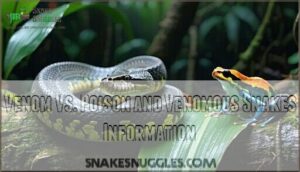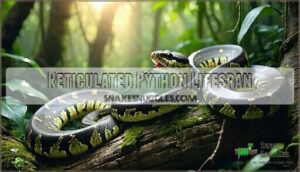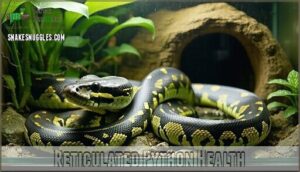This site is supported by our readers. We may earn a commission, at no cost to you, if you purchase through links.

You’re looking at potential bacterial infections, significant bleeding, and wounds that’ll need proper medical care. Their bite won’t poison you, but those curved teeth can grab and tear flesh effectively – it’s their hunting design at work.
Clean the wound immediately, apply pressure to stop bleeding, and get medical attention for antibiotics. Unlike venomous snakes, you won’t need antivenom, just solid wound care and infection prevention.
The real danger comes from their incredible size and strength in defensive situations.
Table Of Contents
- Key Takeaways
- Reticulated Python Bites: Characteristics and First Aid
- Venom Vs. Poison and Venomous Snakes Information
- Most Venomous Snakes and Their Characteristics
- Reticulated Python Size
- Reticulated Python Lifespan
- Reticulated Python Appearance
- Reticulated Python Care Level
- Reticulated Python Diet
- Reticulated Python Health
- Reticulated Python Behavio
- Frequently Asked Questions (FAQs)
- What happens when a reticulated python bites you?
- How does a reticulated python catch a human?
- What are the common symptoms of a reticulated python bite?
- How can I prevent getting bitten by a reticulated python?
- Are reticulated python bites usually venomous?
- What is the first aid treatment for a reticulated python bite?
- Can a reticulated python’s bite be fatal to humans?
- Can reticulated pythons swim and hunt underwater?
- How often do reticulated pythons shed skin?
- What temperature range do reticulated pythons need?
- Conclusion
Key Takeaways
- You’ll face deep puncture wounds from 100+ curved teeth – Reticulated python bites create multiple puncture wounds and lacerations that can reach 0.5-2 cm deep, causing significant bleeding in 45-67% of cases.
- Clean immediately and seek medical care – You need to wash the wound with soap and water right away, apply pressure to control bleeding, and get medical attention for antibiotics, since there’s no antivenom needed.
- They’re non-venomous but still dangerous – Unlike venomous snakes, reticulated pythons won’t inject toxins, but their massive size and strength make them formidable through constriction rather than venom.
- Infection prevention is your main concern – Bacterial infections pose the greatest risk from python bites, so proper wound care and antibiotic treatment matter more than worrying about venom that doesn’t exist.
Reticulated Python Bites: Characteristics and First Aid
When you’re dealing with a reticulated python bite, you’ll face puncture wounds from up to 150 sharp, backward-curved teeth designed to grip prey.
These massive constrictors pack 150 razor-sharp, backward-curved teeth that can cause serious injury even without venom.
These non-venomous bites can still cause significant injury, deep lacerations, and bacterial infections if not treated properly.
Snake Bite Characteristics
When a reticulated python bites, you’ll encounter multiple puncture wounds from its curved teeth arranged in six rows.
These snake bite characteristics create distinctive injury patterns that affect bite severity and wound types.
Key bite features include:
- Semi-circular puncture pattern from curved jaw structure
- 0.5 to 2 cm bite depth reaching blood vessels or muscle
- Tearing motion that increases laceration risk beyond typical snake bites
- Significant bleeding in 45-67% of cases due to teeth anatomy
The handling impact determines injury extent – forceful removal worsens wounds while calm detachment minimizes damage, affecting overall infection risks.
First Aid and Myths
Knowing what to do after a python bite can make the difference between a minor incident and a serious medical emergency.
Clean the wound immediately with soap and water to reduce infection risk by over 30%. Apply gentle pressure with sterile gauze to control bleeding, but don’t panic if you see multiple puncture marks. An important step is to use an effective wound cleanser to help prevent infection.
| Do This | Don’t Do This | Why It Matters |
|---|---|---|
| Clean with soap/water | Cut the wound open | Prevents bacterial infection |
| Apply gentle pressure | Use tourniquets | Controls bleeding safely |
| Seek medical attention | Suck out "venom" | Prevents complications |
| Keep bite elevated | Apply ice directly | Reduces swelling risk |
Despite common snake bite myths, reticulated python bites require no antivenom since they’re non-venomous.
However, their 100+ backward-facing teeth create deep puncture wounds that need proper snake bite treatment to prevent infection signs like redness and swelling.
Venom Vs. Poison and Venomous Snakes Information
You need to understand the difference between venom and poison before evaluating snake bite dangers.
While reticulated pythons aren’t venomous, recognizing venomous snake symptoms can help you respond appropriately to any snake encounter.
Venom Vs. Poison
Understanding the difference between venom and poison can save your life.
Toxins Defined: venom gets injected through fangs, while poison causes harm when swallowed or touched.
Delivery Methods vary substantially between these toxic substances.
| Aspect | Venom | Poison |
|---|---|---|
| Entry Method | Injected via bite/sting | Ingested, inhaled, absorbed |
| Snake Examples | Cobra, rattlesnake | None (snakes aren’t poisonous) |
| Treatment | Medical Antivenom available | Varies by toxin type |
Reticulated pythons are nonvenomous constrictors, meaning they don’t inject venom through snake bites.
Their Evolutionary Advantages come from crushing prey, not toxic Toxicity Levels.
When dealing with snake venom emergencies, remember that snake bites from venomous species require immediate medical attention, while nonvenomous python bites need wound care and infection prevention.
Venomous Snakes and Symptoms
Now that you understand the difference between venom and poison, let’s examine venomous snakes and their bite symptoms.
Over 600 snake species worldwide are venomous, with vipers, cobras, and kraits causing most serious envenomations.
Snake Identification becomes essential since venom effects vary dramatically between species.
You’ll notice fang puncture marks at bite sites, often accompanied by immediate swelling and bruising.
Bite symptoms develop rapidly – up to 80% of victims experience severe radiating pain, while 30-50% develop nausea, vomiting, or dizziness within hours.
Venom toxicity determines symptom severity.
Neurotoxic bites may cause blurred vision or paralysis in 10-40% of cases, while hemotoxic bites trigger bleeding disorders in 60% of victims.
| Snake Type | Primary Venom Effect | Key Symptoms |
|---|---|---|
| Vipers | Tissue destruction | Swelling, bleeding, necrosis |
| Cobras | Nervous system | Paralysis, breathing difficulty |
| Kraits | Neurotoxic | Muscle weakness, drooping eyelids |
| Coral Snakes | Neurotoxic | Slurred speech, confusion |
| Sea Snakes | Muscle damage | Muscle pain, kidney failure |
Antivenom treatment within 2-4 hours reduces mortality by 75%.
Understanding these differences helps you respond appropriately during snake safety emergencies.
Most Venomous Snakes and Their Characteristics
The world’s deadliest venomous snakes pack enough toxic punch to drop an elephant.
These serpents have evolved sophisticated venom delivery systems that make them nature’s most efficient killers.
Venom Potency varies dramatically between species.
The inland taipan delivers the most toxic bite, with venom potency reaching 0.025 mg/kg LD50.
Meanwhile, king cobras compensate for lower toxicity by injecting massive amounts—up to 400mg per strike.
Snake Fangs act like hypodermic needles, efficiently delivering deadly cocktails into victims.
Neurotoxins shut down your nervous system, causing paralysis and respiratory failure.
Hemotoxins destroy blood cells and tissue, leading to internal bleeding and organ damage.
Snake bite symptoms develop rapidly.
You’ll experience swelling, numbness, and severe pain initially.
Neurotoxic effects include blurred vision and difficulty breathing.
Hemotoxic reactions cause bruising and uncontrolled bleeding.
Snake bite prevention starts with awareness.
Avoid tall grass and rocky areas where venomous snakes hide.
Snake bite first aid requires immediate medical attention.
Antivenom Efficacy depends on quick administration—delays can prove fatal.
Reticulated Python Size
Reticulated pythons rank among nature’s most impressive serpents in terms of sheer size. These Southeast Asian giants regularly reach 13-16 feet in length, though some specimens stretch beyond 20 feet.
The maximum length on record? A staggering 25 feet, 2 inches for "Medusa," who tipped the scales at 350 pounds. You’ll find significant variation in reticulated python size depending on the subspecies.
Mainland populations grow largest, while island "super dwarf" forms rarely exceed 8 feet. Sexual dimorphism plays a key role – females consistently outgrow males, sometimes by several feet.
They’re commonly found in the tropical forest regions of Southeast Asia. Average weight ranges from 30-40 pounds for typical adults, though large specimens can weigh 165 pounds or more.
Growth rate depends heavily on food availability and environmental conditions. In captivity, well-fed pythons often surpass their wild counterparts in both snake length and bulk, making proper enclosure planning essential for anyone considering these remarkable constrictors.
Reticulated Python Lifespan
Your python’s lifespan depends on whether it lives in captivity or wild conditions.
Captivity lifespan averages 20-25 years with proper care, while wild longevity typically ranges 15-20 years due to environmental impact from predators and harsh conditions.
Growth factors like diet quality and temperature control substantially affect longevity.
Genetic influence also plays a role in overall health outcomes for these remarkable snakes.
- Longevity Records: The oldest recorded reticulated python lived 32.5 years in captivity, showing how proper husbandry extends life expectancy.
Reticulated Python Appearance
Beyond the impressive lifespan statistics, you’ll notice reticulated pythons showcase remarkable diversity in their physical appearance. These snakes display complex geometric patterns featuring black and yellow bordered diamonds along their backs.
Their reticulated python skin creates intricate net-like designs that earned them their name. Color morphs range from olive green to dark green, white, black, and gold combinations.
Males typically reach 14 feet while females exceed 20 feet. Their distinctive head shape features heat-sensing pits and orange-red eye color.
| Feature | Description |
|---|---|
| Pattern Variations | Diamond-shaped geometric designs with black/yellow borders |
| Scale Details | Net-like reticulated pattern across entire body |
| Color Morphs | Olive green, dark green, white, black, gold combinations |
| Head Shape | Triangular with distinct heat-sensing pits on labial scales |
| Eye Color | Orange to orange-red iris coloration |
Reticulated Python Care Level
Most snake enthusiasts don’t realize that caring for reticulated pythons demands serious Experience Needed – these aren’t beginner pets. You’re dealing with animals that can reach 20+ feet and weigh over 200 pounds.
Housing Requirements become your biggest challenge. You’ll need custom enclosures measuring at least 8x4x4 feet for adults, with secure locks that won’t budge. Think Fort Knox, not fish tank. Proper heating, humidity controls, and multiple hiding spots are non-negotiable reticulated python facts. For specialized setups, you might want to think about a complete python enclosure.
Feeding Frequency varies dramatically – juveniles eat weekly, while adults might go months between meals. This isn’t your typical python care routine.
Temperament Concerns make handling risky business. Even docile individuals can deliver serious python bites without warning. Never handle alone, and always respect their strength during snake handling.
Enrichment Needs include climbing branches and swimming areas. Without proper snake care, these intelligent animals become stressed and aggressive. You’re managing a living, breathing escape artist with serious attitude, in a manner that’s basically managing.
Reticulated Python Diet
Understanding your reticulated python’s dietary needs is essential for proper care. These powerful constrictors have evolved specific hunting strategies that translate directly to their captive diets.
Preferred Prey:
- Wild reticulated pythons hunt mammals, birds, and reptiles using ambush tactics
- Captive snakes thrive on rodents like rats, rabbits, and appropriately-sized prey items
Prey Size:
The golden rule? Your python’s meal should be roughly the same width as the thickest part of their body. Hatchlings start with pinkie mice, while adults can handle rabbits or large rats.
Feeding Frequency:
Young pythons eat weekly due to rapid growth, but adults only need feeding every 2-4 weeks. Their slow metabolism means they’re not always hungry.
- Monitor your snake’s body condition – a well-fed python should have a slightly rounded body without visible ribs or spine.
Reticulated python facts show these giants can fast for months without harm, so don’t worry if your snake occasionally refuses a meal during shedding or seasonal changes. Many owners find it convenient to purchase python food online for consistent supply.
Reticulated Python Health
Keeping your reticulated python healthy requires regular monitoring and preventive care.
Watch for common health issues that can affect these large constrictors.
| Health Issue | Symptoms | Prevention |
|---|---|---|
| Respiratory Infections | Wheezing, mouth breathing, mucus | Maintain proper humidity (60-80%) and temperature gradients |
| Scale Rot | Dark spots on belly scales, soft patches | Keep substrate dry, guarantee good ventilation |
| Parasite Prevention | Weight loss, poor appetite, lethargy | Regular fecal exams, quarantine new animals |
| Obesity Risks | Difficulty moving, fat deposits | Feed appropriate prey size every 2-3 weeks |
| Brumation Issues | Extended inactivity, refusing food | Monitor seasonal changes, maintain consistent environment |
Snake veterinarians recommend annual check-ups to catch problems early.
Reticulated pythons use their heat-sensing pits to detect prey in the dark, but these pits can also be susceptible to damage if the snake’s environment isn’t properly maintained.
After any snake bite incident, monitor for signs of infection around wounds.
Proper husbandry prevents most snake health problems before they start.
Reticulated Python Behavio
Reticulated python behavior varies dramatically between wild and captive environments.
Wild aggression includes loud hissing and defensive striking when threatened, while captive behavior tends toward docility with proper care.
Temperament variations exist among individuals—some recognize their owners while others remain unpredictable.
- Handling techniques require two people for large adults to prevent python bite injuries and guarantee safety during interactions.
Environmental enrichment through climbing structures and hiding spots reduces stress-related behaviors.
Python bite prevention starts with reading body language: rapid tail movement and defensive postures signal danger.
Understanding these behavioral cues helps minimize python bite risks while maintaining your reticulated python’s mental well-being.
Frequently Asked Questions (FAQs)
What happens when a reticulated python bites you?
Take Sarah, a keeper who got bitten while feeding her 15-foot python.
You’ll experience deep puncture wounds from 100+ curved teeth, significant bleeding, and potential bacterial infection requiring immediate wound cleaning and medical attention.
The incident would necessitate urgent care to prevent further complications, including significant bleeding.
How does a reticulated python catch a human?
Reticulated pythons catch humans through ambush hunting – they wait motionlessly in tall grass or near water sources.
They then strike with lightning speed when you walk too close, coiling around you before you can react or escape, utilizing their lightning speed to capture their prey.
What are the common symptoms of a reticulated python bite?
Just 1-2 medically significant python bite cases occur yearly in places like Singapore.
You’ll experience deep puncture wounds, lacerations, bleeding, and infection risk from their 100-150 backward-facing teeth designed for gripping prey.
How can I prevent getting bitten by a reticulated python?
Stay calm around pythons, recognize stress signs like hissing, avoid handling during feeding or shedding, use proper techniques supporting their body, and maintain appropriate housing conditions.
Are reticulated python bites usually venomous?
Despite their fearsome reputation, reticulated python bites won’t poison you. These massive constrictors are completely non-venomous, relying on their powerful coils rather than toxic chemicals to subdue prey.
What is the first aid treatment for a reticulated python bite?
Clean the wound immediately with warm water and antiseptic soap.
Apply pressure to control bleeding.
Don’t forcefully remove the snake—this worsens injuries.
Seek medical attention for severe bites or infection signs.
Can a reticulated python’s bite be fatal to humans?
Imagine this scenario: you’re face-to-face with nature’s ultimate constrictor.
While reticulated python bites aren’t venomous, they’re rarely fatal.
You’ll face puncture wounds and infection risks, but death from the bite itself is extremely unlikely in humans, making infection a more significant concern.
Can reticulated pythons swim and hunt underwater?
You’ll find reticulated pythons are excellent swimmers who can hunt underwater. They’re often spotted far out in oceans and rivers, using their swimming skills to catch aquatic prey effectively.
How often do reticulated pythons shed skin?
Like watching nature’s wardrobe renewal, you’ll see your reticulated python shed every 4-8 weeks as juveniles.
But adults shed less frequently—about every 2-4 months depending on growth rate and environmental conditions.
What temperature range do reticulated pythons need?
You’ll need to maintain your reticulated python’s enclosure between 78-88°F during the day, with a basking spot reaching 90-95°F. Nighttime temperatures can drop to 75-80°F safely.
Conclusion
Despite common fears about giant snakes, reticulated python bites aren’t life-threatening emergencies like venomous snake encounters.
Understanding reticulated python bites through this guide with pictures and facts shows you’re dealing with mechanical injury, not toxin exposure.
These powerful constrictors cause puncture wounds requiring standard wound care – cleaning, pressure, and medical evaluation for infection prevention.
While their size demands respect, proper knowledge removes unnecessary panic, allowing you to understand the real risks versus the myths surrounding these impressive reptiles.
You’ll handle these situations confidently when you understand the risks and take appropriate action.
- https://kids.kiddle.co/Reticulated_python
- https://animaldiversity.org/accounts/Python_reticulatus/
- https://en.wikipedia.org/wiki/Reticulated_python
- https://www.skullsunlimited.com/blogs/educational-resources/beyond-the-scales-the-astonishing-world-of-the-reticulated-python
- https://www.britannica.com/animal/reticulated-python













